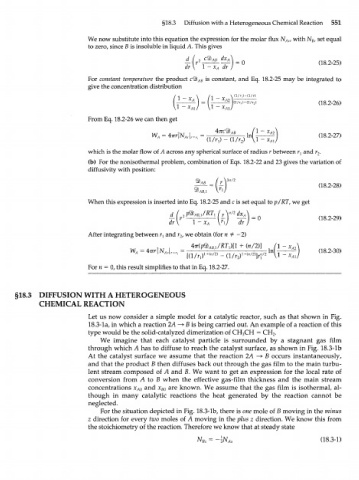Page 571 - Bird R.B. Transport phenomena
P. 571
§18.3 Diffusion with a Heterogeneous Chemical Reaction 551
We now substitute into this equation the expression for the molar flux N , with N set equal
Br
Ar
to zero, since В is insoluble in liquid A. This gives
dr
dr V l~x A dr )
For constant temperature the product сЯЬ АВ is constant, and Eq. 18.2-25 may be integrated to
give the concentration distribution
( 1 8 - " 2 6 )
2
From Eq. 18.2-26 we can then get
(l-x A
which is the molar flow of A across any spherical surface of radius r between r and r .
x 2
(b) For the nonisothermal problem, combination of Eqs. 18.2-22 and 23 gives the variation of
diffusivity with position:
(18.2-28)
When this expression is inserted into Eq. 18.2-25 and с is set equal to p/RT, we get
d
=0 (18.2-29)
After integrating between г and r , we obtain (for n Ф -2)
2
л
1 + (И/2)]
For w = 0, this result simplifies to that in Eq. 18.2-27.
§18.3 DIFFUSION WITH A HETEROGENEOUS
CHEMICAL REACTION
Let us now consider a simple model for a catalytic reactor, such as that shown in Fig.
18.3-1 a, in which a reaction 2A —> В is being carried out. An example of a reaction of this
type would be the solid-catalyzed dimerization of CH CH = CH .
3
2
We imagine that each catalyst particle is surrounded by a stagnant gas film
through which A has to diffuse to reach the catalyst surface, as shown in Fig. 18.3-lb
At the catalyst surface we assume that the reaction 2A —> В occurs instantaneously,
and that the product В then diffuses back out through the gas film to the main turbu-
lent stream composed of A and B. We want to get an expression for the local rate of
conversion from Л to В when the effective gas-film thickness and the main stream
concentrations x A0 and x B0 are known. We assume that the gas film is isothermal, al-
though in many catalytic reactions the heat generated by the reaction cannot be
neglected.
For the situation depicted in Fig. 18.3-lb, there is one mole of В moving in the minus
z direction for every two moles of A moving in the plus z direction. We know this from
the stoichiometry of the reaction. Therefore we know that at steady state
N 6 2 = -\N Az (18.3-1)

